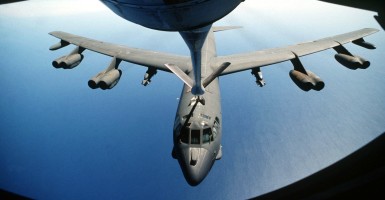Early in February, the Obama administration released its fiscal year (FY) 2017 budget request. In the budget request, the president continues to fund a number of essential nuclear weapon modernization and sustainment programs. The significance of these programs is likely to increase in coming years, as Russia continues to increase reliance on its rapidly expanding modern nuclear arsenal and as other countries become more nuclear-capable.
A major element of the administration’s budget request for strategic systems is the new Long Range Strategic Bomber, recently awarded to Northrop Grumman for development. Initially estimated to cost about $12.6 billion, the administration decreased is projections to about $9.1 billion between FY2017 and FY2020, reportedly due to manufacturers’ competition.
A follow-on bomber is important not only to augment U.S. deterrence posture in the era of advanced adversarial air defense systems, but also because today’s bombers, some of them over 50 years old, serve a wide range of conventional missions that will be relevant in the future.
A critical component of penetrating enemy air defense is the Long-Range Stand Off (LRSO) weapon that is funded at $95 million, about $38 million less than what the president requested last year. The Long-Range Stand Off is designed to replace the Air Force’s current nuclear-capable cruise missile, which was designed in 1970s, deployed in 1980s, and originally intended for a 10-year lifespan.
The Air Force is also preparing to replace the Minuteman III intercontinental-range ballistic missile (ICBM). The Minuteman III ICBM was developed in the 1960s and is the one of the oldest components of the U.S. strategic arsenal. The United States has had concern over its survivability since the 1980s as other countries have continued to improve the accuracy and effects of their nuclear systems, potentially putting the survivability of the Minuteman system at risk.
The president’s budget provides almost $114 million for the development of the follow-on missile, an increase from $75 million last year, although still $6 million below what the president projected he would request this year in the last year’s budget.
The National Nuclear Security Administration (NNSA) is the government agency responsible for the sustainment of U.S. nuclear warheads. The president requested $9.2 billion for the Weapons Activities account from which a majority of U.S. warhead work is funded. During the Senate debate over ratification of the New Strategic Arms Reduction Treaty (New START), the president pledged to request between $8.9 and $9.0 billion. In the FY2017 budget request, the administration is actually requesting an amount above the pledged level, which is good and necessary given the abysmal state of U.S. nuclear infrastructure where nuclear weapons-related activities are conducted.
The president’s request is relatively weak on U.S. missile defense programs. Between the FY2016 budget as enacted and the amount requested for FY2017, the administration cut $700 million from missile defense programs at a time when Iran and North Korea continue to advance long-range ballistic missiles with an explicit purpose of threatening the United States.
The Missile Defense Agency (MDA), responsible for the development, testing, and fielding of U.S. missile defense programs, will be funded at a little over $7.5 billion if the president has his way, down from $8.3 billion enacted in FY2016.
While the Ground Based Midcourse Defense program is getting cut by $400 million (between FY2016 enacted and FY2017 requested), the number of interceptors remains to be 44 by the end of 2017 according to the administration’s plan.
If the number of interceptors will be the same, it remains to be seen where the $400 million in cuts will be taken. Additionally, the administration is not providing for space-based missile defense systems, which would be most effective in addressing the continued ballistic missile threat.
The administration is also cutting procurement of the Standard Missile-3 Block IB interceptor, a more advanced interceptor capable of addressing short- and medium-range ballistic missiles from land or sea and one of the elements of the European Phased Adaptive Approach, the president’s missile defense plan for the protection of U.S. allies in Europe and U.S. forward-deployed troops from medium-range ballistic missiles, particularly those from Iran.
The United States cannot afford to continue to neglect its nuclear arsenal; neither can it afford to neglect protecting its citizens, forward-deployed troops, and allies from ballistic missile threats. U.S. nuclear weapons modernization is way overdue, with a majority of the delivery platforms performing way longer than their projected lifespans.
While the president’s budget request provides much needed funding for nuclear modernization and warhead sustainment, continued attention throughout the next several decades will be necessary to ensure that the United States has the capabilities and flexibility it needs to deal with a more complex deterrence environment in the future.
The administration should increase investments in a layered comprehensive ballistic missile defense system that would deny U.S. adversaries’ benefits stemming from possessing ballistic missiles that can reach the United States within minutes and threaten our way of life.




























